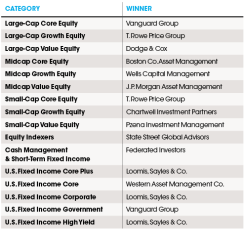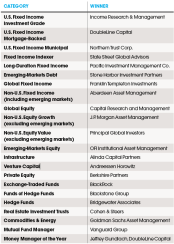Please visit our Storify to view all of the press and social media coverage of Institutional Investor's 4th Annual U.S. Investment Management Awards.
Jeffrey Gundlach is a self-described chicken. The CEO of DoubleLine Capital, which he co-founded in 2009 after leaving TCW Group in a high-profile separation, has built a career around understanding his risks and shielding clients from big losses. Investors have been well rewarded, as Gundlach's cowardice has prompted him to build innovative fixed-income portfolios that withstood the carnage of 2008 and delivered outsize returns from mortgage-backed and other securities he added at the market lows in 2009. Since then Gundlach has deftly negotiated the difficult low-yield environment.
"What I'm choosing to do is to have a 'tastes great, less filling' concept rather than going for the gusto all the way," says Gundlach, who was followed by 45 TCW employees to DoubleLine, which has reached $56 billion in assets in just three years and is one of the U.S.'s fastest-growing money managers. "So our total-return strategy is targeted to have less volatility than a garden-variety bond fund, but having a higher return. If we allowed the strategy to have the same volatility as a garden-variety fund, then our returns would be even higher, but it would come at the cost of great volatility."
The Winners' Circle
| Category | Name / Company |
| Large Corporate | Kathleen Lutito CenturyLink Ivestment Management |
| Small Corporate | Ronald Meyers Idaho Power Co. |
| Large Endowment | Kathryn Crecelius Johns Hopkins University |
| Small Endowment | George Moss LSU Foundation |
| Large Foundation | Joseph Boateng Casey Family Programs |
| Small Foundation | Susan Racher Wallace H. Coulter Foundation |
| Large Public Plan | Thomas (Britt) Harris Teacher Retirement System of Texas |
| Small Public Plan | Laurnz (Larry) Swartz Fairfax County Retirement Systems |
| Investor Lifetime Achievement Award | Linda Strumpf Leona M. and Harry B. Helmsley Charitable Trust |
| Manager Lifetime Achievement Award | Raymond Dalio Bridgewater Associates |
Other winners include Berkshire Capital, BlackRock, Blackstone Group, Franklin Templeton Investments, Principal Global Investors, Pzena Investment Management, State Street Global Advisors, T. Rowe Price Group and Vanguard Group. Our honorees were chosen by institutional investors, including top endowments, foundations, corporate pension plans, public pensions and family offices, in a survey sent out in February.
Though many of our winners shine in their categories by having immersed themselves in a particular specialty for decades, they also know that investing has gotten more difficult as competition has increased and as macro issues that can rock stock and bond markets have taken center stage. As a result, the best investors are leveraging creative research and new ways of thinking about old problems. They are also continually investing in the resources needed to make intelligent, comprehensive decisions on what to buy and sell.
| Other Winners (Click to Enlarge) |

|

|
The winners of the U.S. Investment Management Awards in 2013 were selected through a process that we've been refining for four years. Last year we divided the equity categories into core, value and growth to better reflect how portfolios are run. This year we added three categories, including Long-Duration Fixed Income, recognizing that corporate plans and others are increasingly employing liability-driven approaches to constructing their portfolios.
Using data from eVestment and other institutional database providers, II screened managers and picked the top ones based on short- and long-term performance, Sharpe ratios and other risk measures. We then asked more than 1,000 investors to vote on their favorite managers from the short lists we provided in 38 different sector, strategy and product categories; voters also could write in their own picks. It wasn't only performance that drove our voters' decision making. We also asked them to consider criteria such as conviction of ideas, tenure, customer service, attention to risk, research capabilities and the ability to weather market cycles.
Our U.S. Investment Management Awards also honored the best fiduciaries of small and large corporate pension plans, public pensions, endowments and foundations (page 44). Our team of editors and writers identified these investors through independent research. Good old-fashioned journalism allows us to highlight fiduciaries who exhibit innovation, creativity and leadership and who create well-constructed portfolios that will stand the test of time.
Last year's market was defined by low yields in the bond market. Investors chased junk bonds, emerging-markets debt and real estate investment trusts that were investing in residential property for the first time. Money managers started furiously debating whether this would be the year when interest rates start to rise, and investors once again moved to put more money into equities.
With that as a backdrop, Los Angeles–based DoubleLine, a firm that has had huge success launching bond funds, including core fixed income, mortgage-backed securities, developed credit and emerging markets, is getting into the equity business. Gundlach says industry thinking around equity investing is stale, particularly the now ubiquitous nine-box grid that tries to define stock pickers. "Rather than call evolving a portfolio based on market conditions and pricing the pejorative term 'style drift,' let's call it something positive like active management," says Gundlach. "We are going to try to outperform a passive approach by moving money around, just like we've done in the fixed-income world."
DoubleLine is starting with a small-cap fund. Separately, in line with his experience in developing portfolios that work in a variety of scenarios and don't expose investors to catastrophic losses, Gundlach has recommended several paired trades. In April 2012 he suggested that investors short Apple, which then was trading around $600 a share, thinking that the company could only do so much to excite people about its products and successive versions of the iPhone. But he also knew that high-momentum trades, whether of stocks or currencies, can persist for far longer than anyone expects, even if valuations are seemingly irrational. So the risk-averse Gundlach paired the Apple short with a long on natural gas. He reasoned that if Apple continued its upward rise — and it did until it hit $705 a share in September — the overall environment would be bullish and natural gas would rally. At the time of his call, a play on natural gas could be bought cheaply. Apple has since fallen to about $400 a share, and natural gas has doubled, to more than $4.00 per million BTUs.
Gundlach is looking to bring this multidimensional thinking to the world of equity investing. "What institutions have done is filled up the entire equity market with these boxes of managers, piling them on top of each other and next to each other," he explains. "But what they end up getting is a convoluted and expensive index fund." Gundlach is taking a page from his own playbook: He pioneered the multisector bond fund that could take bets in different areas of fixed income.
Investing in commodities is an object lesson in how successful money managers today have to weigh the complex effects of macroeconomic policy decisions on world markets and every security choice. At the same time, investors increasingly want their commodities managers to depart significantly from benchmarks in their search of returns.
Michael Johnson, portfolio manager on the five-person commodities team at New York–based Goldman Sachs Asset Management, winner in the Commodities & Energy category, says his crew makes choices based on fundamentals. The GSAM team — which oversees investments for long-only, long-short and unconstrained portfolios — assesses both the macroeconomic picture and the physical supply-demand details in particular markets. "In some periods the macro environment has been a larger influence, and in other periods the local physical dynamics are more important," says Johnson, whose team benefits from being part of a large global organization. "We can talk to experts in all fields that impact commodities," he says. But Johnson notes that although a big firm can provide big resources, its bureaucracy can slow down a team of investors who need a certain level of nimbleness to compete. "We want to be able to move quickly and implement our views in the portfolio," he says.
Unlike a lot of sectors that have seen hard-core competition from passive ETFs and other indexed funds, commodities are moving in the opposite direction. Institutional investors, still fairly new to commodities, started out using passive options or enhanced index funds; now they are adding active risk. "The newness is wearing off, and people are getting more comfortable with active managers," says Johnson. "The move to active will be a theme for the next five years. We're still in the early stages."
Some fundamental managers are reorganizing themselves around macroeconomic trends. That's the case with $49.3 billion-in-assets Cohen & Steers, the winner in Real Estate Investment Trusts. The firm's founders, Robert Steers and Martin Cohen, focused exclusively on REITs until about a decade ago, then slowly expanded into other income-producing investments. Now New York–based Cohen & Steers is betting that investors will want to shield their assets from the harsh effects of inflation — which they think is inevitable given loose monetary policy worldwide — with a real assets strategy that combines REITs with investments such as commodities and natural resources. "What appeals to us about real assets is that the strategy isn't commoditized," Steers says. "It's not easy even for professional investors to execute this on their own." But the co-founders concede that they couldn't do it all themselves; they recently hired a commodities team from GE Asset Management to support the move.
Given the increasing complexity of the investing world, Boston-based Loomis, Sayles & Co., a winner in three categories — U.S. Fixed Income Corporate, Fixed Income Core Plus and Fixed Income High Yield — has established investment processes that are as well defined as in academia. "In the sciences you wouldn't expect Nobel Prize winners to keep all their wisdom in their head," says CIO Jae Park. He adds that Loomis Sayles' investment processes are constantly monitored and augmented with specialty research by quantitative, corporate, sovereign, currency and dedicated macro groups: "You have to get securities decisions correct in the context of the big picture and get the big picture right and implement it."
Last year Loomis Sayles combined its equity and fixed-income groups, a nod to its belief that because information on investing is coming from all sides, the firm has to be in a position to capture nuances and changes. "It gives us the ability to benefit from the glass-is-half-empty side of the business, fixed income, and from the glass-is-half-full side, equities," adds Park.
Powerful macroeconomic forces have also created opportunities. As the credit crisis laid bare problems in the developed world, the emerging markets were recognized for having taken steps to reform their economies. Franklin Templeton Investments, winner in the Global Fixed Income category, has found some of its best investment opportunities in global markets where information is scarcer and experienced firms have an edge. "We increasingly spend time in analyzing the macro outlook for different regions and then different countries," says Christopher Molumphy, CIO of fixed income at the San Mateo, California–based firm. "This is at the top of our list in terms of where we see opportunities for investors and where we can create value in our portfolios."
Being an expert in a particular sector can give a firm an advantage, but investors are increasingly looking for customized portfolios that include a broad range of asset classes and subspecialties. Legg Mason believes its multiaffiliate model provides the best of both worlds: smaller, independent shops that can offer better performance than big integrated firms and a parent that can furnish services such as tailored portfolios. "Candidly, it's one of the reasons asset managers are under pressure these days; it's hard to do and expensive," says Joseph Sullivan, who took on the CEO role at the Baltimore-based firm in February. Legg Mason's global asset allocation group customizes portfolios using products from all affiliates, as well as select ETFs, and dynamically hedges and rebalances according to clients' objectives.
Understanding macroeconomic factors can help fundamental managers see pockets of volatility and resulting equity mispricings. "So many people are trying to get a leg up on the relatively short-term information flow," says Jonathan Simon, New York–based head of the Value Equities team at J.P. Morgan Asset Management, winner of the Midcap Value Equity category. "That creates volatility, and volatility makes my job as a traditional value manager easier."
Some managers stick to the fundamentals of selecting good companies and don't worry too much about the bigger picture. Shane Duffy, lead portfolio manager of J.P. Morgan's international growth strategy, winner of the Non-U.S. Equity Growth (excluding emerging markets) category, says the fragile situation in Europe made growth companies more attractive than value stocks last year. But, he adds, the macro picture is just that — macro. "For this portfolio it's a series of micro decisions, finding conviction at the stock level," he notes. "For 2013, will Japan be a theme? Probably. But I won't impose a grand vision on the portfolio."







